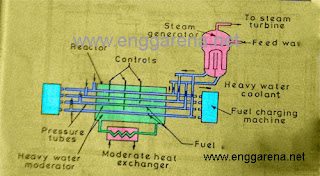Table of Contents
What is a CANDU Reactor?
A reactor developed and designed by Canadian is called CANDU (CANadian Deuterium Uranium ) reactor.
It uses pressurized heavy water (which has 99.8% deuterium oxide ) as a moderator and primary coolant. Natural Uranium is used as fuel for this reactor.
A Canadian Deuterium Uranium Pressurized Heavy Water power plant is shown in the figure.
 |
| CANDU Reactor Power Plant |
Construction and Working of CANDU Reactor
- Natural uranium used as fuel is in the form of small cylinder pallets. These are packed in corrosion-resistant Zirconium alloy tubes of 0.5 cm long and 1.3 cm in diameter to form a fuel rod.
- These short rods are combined in 37 bundles of 37 rods and 12 bundles are placed end to end in each pressure tubes.
- This type of arrangement helps in refueling the reactor while in operation.
- The reactor vessel is a cylinder called Calandria. It is placed horizontally. It has pressure tubes penetrating the reactor vessel. The active core is about 6 m high and 7-8 m in diameter.
- In the primary circuit, the deuterium coolant enters the array of pressure tubes at 110 bar pressure and 260 degrees Celsius temperature. It flows through the fuel element and leaves the pressure tubes at about 370 degrees Celsius after absorbing the heat generated by the fission of fuel material.
- The coolant at 110 bar and 370 degrees leaving the reactor enters the steam power plant where the generated steam is used in the conventional steam power plants.
- Control rods are made up of cadmium. These control rods are used to start and shut down the reactor. In addition, there are other absorbing rods that are used to control the power output during reactor operation.
Also read: Different Types of Nuclear Reactors
Advantages of CANDU Reactor :
1. Enriched fuel is not required.
2. The cost and time of construction are less.
3. It has a good neutron economy resulting in a good breeding ratio.
4. Heavy water is used as a moderator which has low fuel consumption.
Disadvantages of CANDU Reactor :
1. Heavy water used as a moderator is costly.
2. A leakage problem may occur.
3. It has critical temperature limitations.
4. It requires has a standard of design, manufacture, and maintenance.
5. The size of the plant is large.





I’m extremely impressed with your writing skills and also
with the layout on your weblog. Is this a paid theme or did you modify it yourself?
Anyway keep up the excellent quality writing, it is rare to see a great
blog like this one nowadays.
You ought to be a part of a contest for one of the most useful websites on the net.
I’m going to highly recommend this site!
I read this post completely concerning the difference of most recent and
previous technologies, it’s awesome article.